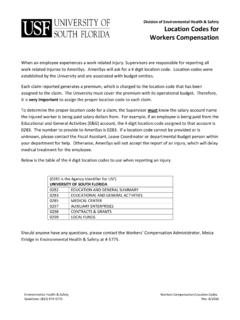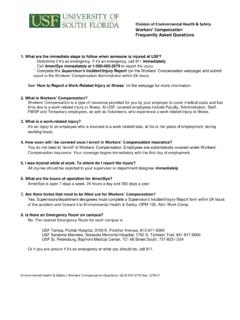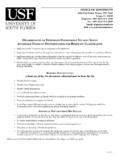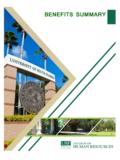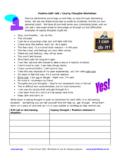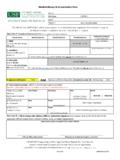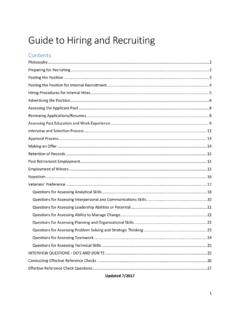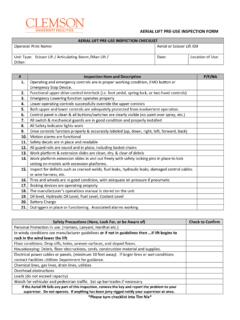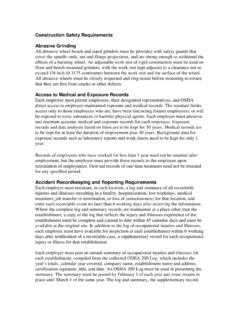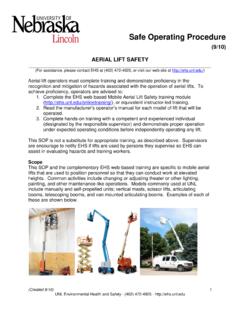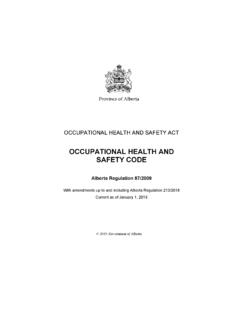Transcription of Job Safety Analysis - University of South Florida
1 Sample Job Safety Analysis Information Activities Abrasive Blast Cabinet .. 2 aerial Lift .. 4 Air Compressor (portable, electric) .. 7 Angle 9 Arc Welding .. 12 Backpack Sprayer .. 14 Band Saw .. 16 Belt Sander (Portable) .. 17 Belt Sander (Stationary) .. 19 Bench/Pedestal Grinder .. 20 Blower (Gas Powered) .. 22 Chain Saw (Gas Powered) .. 25 Charge Forklift Batteries .. 26 Cordless Drill .. 27 Drill Press .. 29 Edger/Trimmer (Gas Powered) .. 30 Forklift .. 33 Hand Operated Power Tools .. 38 Hedge Trimmer (Gas Powered) .. 40 Hedge Trimmer, Extended (Gas Powered) .. 43 Jig Saw .. 46 Ladder .. 47 Lawnmower (Push, Self Propelled) .. 51 Lawnmower (Zero Turn).
2 53 Lifting/Moving Heavy Objects .. 56 Oxy Acetylene (Cutting) Torch .. 58 2 61 Paper Cutter (Guillotine style) .. 62 Pesticides/Herbicides .. 63 Pole Saw (Gas Powered) .. 64 Pressure Washing (Gas Powered) .. 67 Reciprocating Saw .. 73 Saw (Miter, "Chop", Radial Arm) .. 75 Table Saw .. 77 Tile Saw (Wet).. 79 Vehicle/Equipment Fueling (Fuel Pumps) .. 82 Wood Chipper .. 83 Inspect cabinet, nozzles, hoses, gloves, etc. for defects Dusts Wear N 95 respirator if respirable dusts above safe thresholds. Add/remove blasting media as needed Dusts Wear N 95 respirator if respirable dusts above safe thresholds. Place part to be blasted in the cabinet and secure Control Description Hazard Description Activity Name.
3 Abrasive Blast Cabinet Task Name Sample Job Safety Analysis Information 3 access door/lid Bumps, bruises, cuts, scratches from loading part Wear work gloves when loading parts into cabinet Turn on light, turn on unit, set pressure to required , and ensure exhaust fan is on/working None foreseen None Insert hands into blast cabinet gloves and begin blasting the part Eye irritation from dust and particles escaping cabinet 4 Wear Safety glasses and or face shield while operating blast cabinet Ensure cabinet is closed and dust collection is working Lung irritation from dust and particles escaping cabinet Ensure blast cabinet is securely close and dust collection is operating correctly Hand injury from blasting media Ensure cabinet gloves are intact and use mechanical means to support part as needed.
4 Hearing degradation from excessive noise Have noise level evaluated by EH&S and wear hearing protection if needed. Turn of blasting cabinet and remove part Dusts Allow ventilation to run and media to settle before removing part Bumps, bruises, cuts, scratches from unloading part Wear work gloves when removing part 1. Prepare work area. Activity Name: aerial Lift Task Name Hazard Description Control Description 5 Impact (from operator thrown from basket; co workers, bystanders or passersby who are struck by running into the lift device; or from lift device falling over) Designate an employee to be a ground controller to direct pedestrian and vehicular traffic away from the work location.
5 Position lift device away from traffic. Level carrier/truck base, set brakes and block wheels. When outriggers are used, they shall be positioned on pads or other solid surface. Never exceed the posted lift capacity (including worker, material and tools). Give verbal warnings to people in the work area. Personnel travelling in the basket of an aerial lift shall wear a Personal Fall Arrest System consisting of full body harness with either a restraint line or a self retracting lifeline attached to an appropriate anchorage in the basket. Never use lift as a crane or hoist to lift or lower materials. Utilize barricades, cones or caution tape to keep bystanders a safe distance from the job.
6 Electric shock Position lift device away from power lines. 2. Operate lift device. Fall from heights 6 Use Personal Fall Arrest System (PFAS) when using an aerial lift device. This includes use of a scissors lift. The PFAS must consist of a full body harness, self retracting lifeline or restraint line, connectors and an appropriate anchorage on the boom or basket. Personnel shall not step out of aerial lifts or on the guardrail to perform work or maintenance. Personnel shall always stand firmly on the floor of the basket and shall not sit or climb on the guardrail or the edge of the basket or use planks, ladders, or other devices for a work position.
7 The self retracting lifeline or restraint line must be attached to the anchorage in the basket. An aerial lift shall not be moved when the work platform is elevated in a working position with employees in the basket. Electric shock "Maintain a minimum clearance of 10 feet from energized conductors rated 50 kV phase to phase or less; for lines rated over 50 kV phase to phase, the minimum clearance shall be 10 feet plus 4/10 inch for each kilovolt greater than 50 kV phase to phase. W WARNING: Insulated baskets do not protect operators from other electrical paths to the ground, such as those through trees, through a guy wire or the path from one phase wire to the second phase wire, any of which can be fatal.
8 " Impact (from tree limbs or other cut materials falling onto the basket or tools and materials falling from the floor of the lift device to the ground) Personnel shall not allow tools or materials to accumulate on the floor of the platform. 7 Personnel in the basket and on the ground working below an elevated aerial lift platform shall wear hard hats. 3. Return lift device to parking/storage area upon completion of work. Impact (from operator thrown from basket) Personnel travelling in the basket of an aerial lift shall wear a Personal Fall Arrest System consisting of full body harness with either a restraint line or a self retracting lifeline attached to an appropriate anchorage in the basket.
9 Activity Name: Air Compressor (portable, electric) Task Name Hazard Description Control Description 1. Perform pre operational check of equipment, , condition of electric cord and plug. Mechanical failure causing injury or damage If deficiencies are noted, remove from service and repair/replace as necessary. Check oil level (if applicable), check that the cord is not damaged, and that everything seems to be in order. 2. Move air compressor to point of use. Ergonomics (back or other strain) Do stretching and warm up exercises before starting work. Lifting/Back Safety training 8 3. Connect air hose to compressor and tool or equipment Compression (from pinched finger while connecting hose) Wear work gloves.
10 4. Insert plug into outlet and turn compressor on. Allow air pressure to increase to desired level. None foreseen None 5. Use air compressor to power tools and equipment. See also JHA Operate a Nail Gun . Impact (from uncontrolled release of air creating projectiles and flying debris) Never use compressed air to clean your body or clothing. Wear Safety glasses with side shields. When used for cleaning purposes, air pressure must be adjusted to less than 30 psi. Ensure air nozzles are equipped with chip deflectors. Noise Wear ear plugs. Electric shock (while performing maintenance/repair on the air compressor) Unplug electric cord and retain control of the plug.
